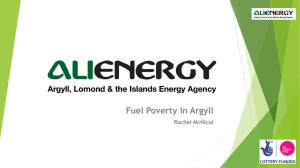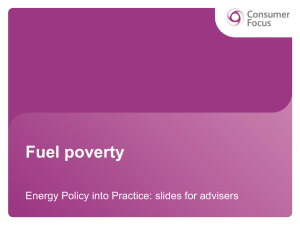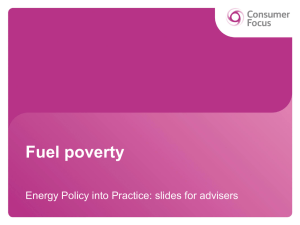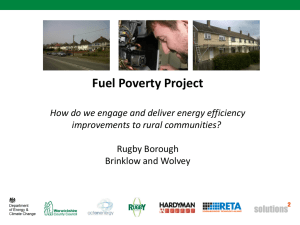Name of presentation
advertisement
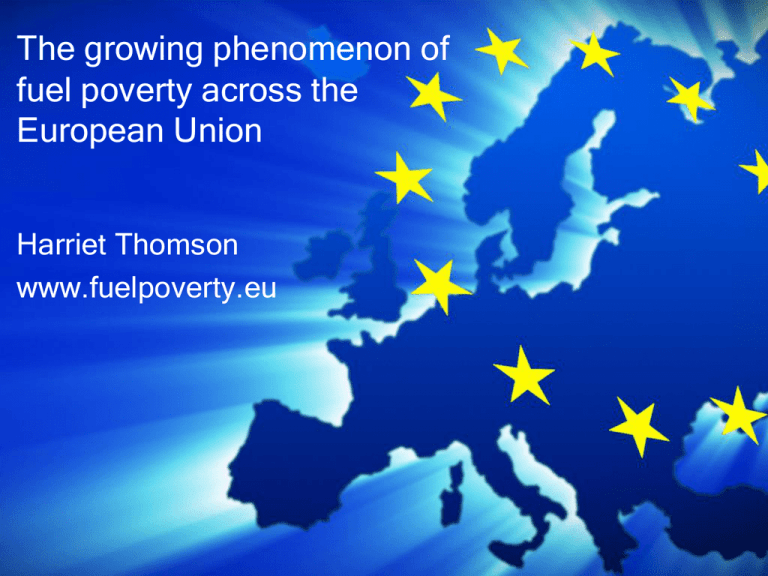
The growing phenomenon of fuel poverty across the European Union Harriet Thomson www.fuelpoverty.eu Background • Only the UK, Ireland and France have a definition • Evident from the literature that fuel poverty is a problem across Europe: – – – – – – – Whyley and Callender (1997) – UK, IE, NL, DE Healy and Clinch (2002) – EU14 Buzar (2007) – Eastern Europe EPEE (2009) – BE, FR, IT, ES, UK Tirado Herrero and Ürge-Vorsatz (2010) – Hungary Huybrechs, Meyer and Vranken (2012) - Belgium Thomson and Snell (2012) – EU25 • Significant gap in knowledge Studying fuel poverty at the EU level • The EU is a powerful political and economic institution that has shaped fuel poverty relevant policy at the member state level, e.g. – – – – – Liberalisation of the gas and electricity markets Europe 2020 targets Requirements for national fuel poverty action plans Requirements for national energy ombudsmen EU Emissions Trading Scheme • Data issues – No standardised fuel expenditure data – UK unique in having a detailed housing survey (EHCS/EHS) – Available data is difficult to access and has weaknesses PhD methods • Longitudinal analysis of consensual data – EU Statistics on Income and Living Conditions – Multilevel modelling • Additional data analysis – Gas and electricity prices – Energy efficiency data – Eurobarometer and European Quality of Life Survey • Content analysis of policy documents Overall, create a typology of EU fuel poverty Consensual measurement • EU Statistics on Income and Living Conditions • Three key proxy indicators: α) Ability to pay to keep the home adequately warm β) Arrears on utility bills within last 12 months γ) Presence of a leaking roof, damp walls or rotten windows • Composite index developed using the following weights for each proxy indicator: Scenario Weighting One 0.50 α + 0.25 β + 0.25 γ Two 0.25 α + 0.50 β + 0.25 γ Three 0.25 α + 0.25 β + 0.50 γ Four 0.33 α + 0.33 β + 0.33 γ Source: Thomson and Snell (2012) Comparison of twice national median fuel spend and composite consensual measurement 35 30 25 20 15 10 5 0 Twice national median fuel spend (2005 HBS) Composite consensual measure (2007 EU-SILC) Source: European Commission (2010) and author analysis of EU-SILC Summary • European fuel poverty research is constrained by the lack of comparable data on household fuel spend, necessitating the use of proxy indicators • Initial analysis confirms previous findings concerning European fuel poverty, and demonstrates that fuel poverty is a problem for most Member States • Despite this, levels of acknowledgement and acceptance of fuel poverty as a policy problem are low across the EU, with only three official definitions Thank you for listening, any questions or comments? hrt500@york.ac.uk www.fuelpoverty.eu References • • • • • • • • Buzar, S. (2007) Energy Poverty in Eastern Europe: Hidden Geographies of Deprivation. Aldershot: Ashgate EPEE, (2009) Tackling Fuel Poverty in Europe: Recommendations Guide for Policy Makers. http://www.fuelpoverty.com/files/WP5_D15_EN.pdf European Commission (2010a) Commission Staff Working Paper: An Energy Policy for Consumers. European Commission, Brussels. Healy, J. D., and Clinch, P. (2002) Fuel poverty in Europe: A crosscountry analysis using a new composite measure. Environmental Studies Research Series, University College Dublin. Huybrechs F., Meyer S. and Vranken J. (2012) Energiearmoede in België.[online] http://www.ua.ac.be/main.aspx?c=*OASES&n=104242 Thomson, H., and Snell, C. (2012) Quantifying the prevalence of fuel poverty across the European Union. Energy Policy, http://dx.doi.org/10.1016/j.enpol.2012.10.009 Tirado Herrero, S. and Ürge-Vorsatz, D. (2010) Fuel poverty in Hungary: A first assessment. Final report. Center for Climate Change and Sustainable Energy Policy, Central European University. Whyley, C. and Callender, C., (1997) Fuel poverty in Europe: evidence from the European Household Panel Survey. National Energy Action, Newcastle upon Tyne.



